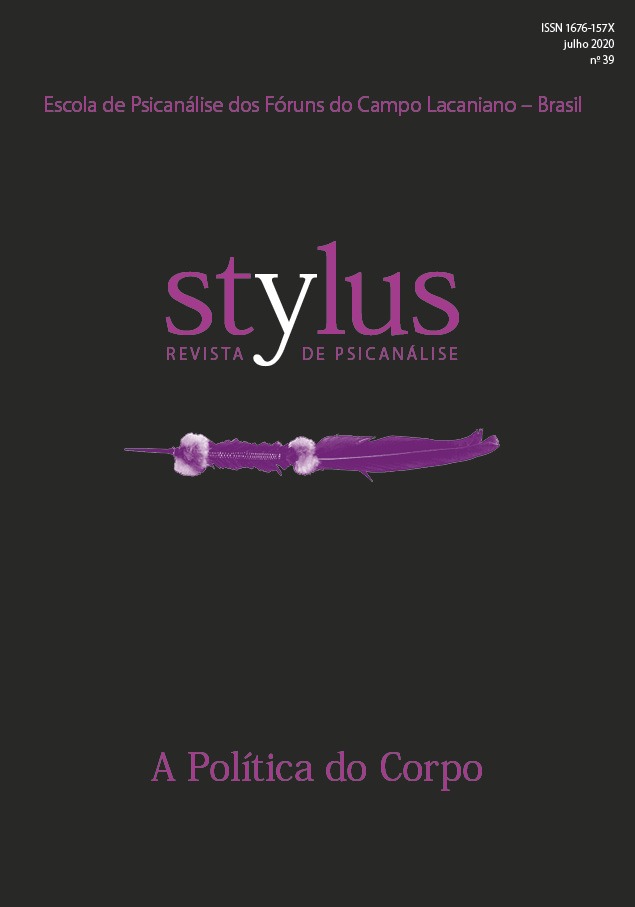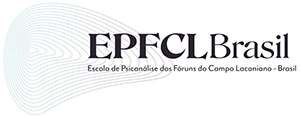The out-body
impasses between holophrase and letter
DOI:
https://doi.org/10.31683/stylus.vi39.462Keywords:
Letter, Holophrase, Symptom, Body, UnconsciousAbstract
The differences between the psychosomatic phenomenon and the symptom are clarified in the psychoanalysis clinic by the holophrase concept, as Lacan presented during his 11th Seminar. However, the holophrase was already an announcement of a symbolic rupture, given that it appears as a real signifier, or as an S1 out of the chain. This is the reason why we can call a holophrase an out-body referring to the “symbolic body”. The real problem was established in the decade of 1970, when Lacan defines the symptom as a letter, a mark of the One, which is out-body. Thus, the question is: holophrase, is that a letter? What kind of “body” was Lacan talking about? The development in the Lacanian theory related to the concepts of the body, the unconscious and the symptom imply a study about what the effects in the body between those two are.
Downloads
References
Bernard, D. (2015). L’énigme, le corps, l’inconscient. Revue Collèges Clinique Psychanalytique Champ Lacanien (RCCCL): L’Inconscient et le Corps, (14), 161-168.
Lacan, J. (s.d.). Joyce le symptôme. In J. Lacan. Autres écrits (pp. 565-570). Paris: Éditions du Seuil.
Lacan, J. (1948). A agressividade em psicanálise. In J. Lacan. Os escritos (V. Ribeiro, Trad.) (pp. 104-126). Rio de Janeiro: Jorge Zahar.
Lacan, J. (1949). O estádio do espelho como formador da função do eu tal como nos é revelada na experiência analítica. In J. Lacan. Os escritos (V. Ribeiro, Trad.) (pp. 96-103). Rio de Janeiro: Jorge Zahar.
Lacan, J. (1960). Subversão do sujeito e dialética do desejo no inconsciente freudiano. In J. Lacan. Os escritos (V. Ribeiro, Trad.) (pp. 793-842). Rio de Janeiro: Jorge Zahar.
Lacan, J. (1964-1965). Séminaire, livre XII: problèmes cruciaux. Inédito. Recuperado de http://staferla.free.fr/S22/S22%20R.S.I..pdf
Lacan, J. (1968). De la psychanalyse dans ses rapport avec la réalité. Scillicet, (1), 51-59. Conferência realizada no Institut Français Milano.
Lacan, J. (1970). Radiophonie. Inédito. Recuperado de http://staferla.free.fr/Lacan/radiophonie.htm
Lacan, J. (1974-1975a). Séminaire, livre XXII: RSI. Inédito. Recuperado de http://staferla.free.fr/S22/S22%20R.S.I..pdf
Lacan, J. (1975b). Conferência em Genebra sobre o sintoma. Recuperado de http://lacanterafreudiana.com.ar/2.5.1.25%20%20%20%20CONFERENCIA%20EN%20GINEBRA%20SOBRE%20EL%20SINTOMA,%201975.pdf
Lacan, J. (1975c-1976). Séminaire, livre XXIII: le sinthome. Inédito. Recuperado de http://staferla.free.fr/S23/S23%20LE%20SINTHOME.pdf
Lacan, J. (1985a). O seminário, livro 2: o eu na teoria de Freud e na técnica da psicanálise (M. D. Magno, Trad.). Rio de Janeiro: Jorge Zahar. (Trabalho original publicado em 1954-1955)
Lacan, J. (1985b). O seminário, livro 11: os quatro conceitos fundamentais da psicanálise (M. D. Magno, Trad.). Rio de Janeiro: Jorge Zahar. (Trabalho original publicado em 1964)
Lacan, J. (2005). O seminário, livro 10: a angústia (V. Ribeiro, Trad.). Rio de Janeiro: Jorge Zahar. (Trabalho original publicado em 1962-1963)
Lacan, J. (2008). O seminário, livro 20: Mais, ainda (M. D. Magno, Trad.). Rio de Janeiro: Jorge Zahar. (Trabalho original publicado em 1972-1973)
Quinet, A. (2012). Os outros em Lacan: psicanálise passo-a-passo. Rio de Janeiro: Zahar.
Soler, C. (1994). Retorno sobre la cuestion del sintoma y el FPS. In V. Gorai. Estudios de psicosomática (2a ed. atual., Vol. 2, pp. 53-60). Circulo Analítico de Psicosomática – CAP.
Soler, C. (2012). Lacan, o inconsciente reinventado. (P. Abreu, Trad.). Rio de Janeiro: José Nazar. (Trabalho original publicado em 2009)
Downloads
Published
How to Cite
Issue
Section
License
Ao encaminhar os originais, os autores cedem os direitos de publicação para STYLUS.
Os autores assumem toda responsabilidade sobre o conteúdo do trabalho, incluindo as devidas e necessárias autorizações para divulgação de dados coletados e resultados obtidos, isentando a Revista de toda e qualquer responsabilidade neste sentido.



